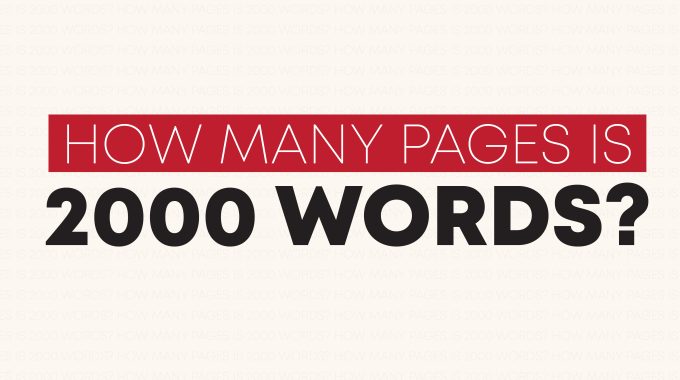Have you ever been asked to write a 2000-word essay or report and wondered just how much space that would take up? Whether you’re a student, a professional, or just someone curious about the world of words, understanding the answer to this question can be helpful. In this article, we’ll delve into the world of word counts, pages, and how they all fit together.
Understanding Word Counts and Page Length
Before we dive into specifics, let’s get a handle on some basic concepts. Word count refers to the total number of words in a document, while page length refers to the physical space those words occupy on a printed or digital page. While these two factors are related, they’re not directly interchangeable.
Factors Affecting Page Length
Several factors influence how many words fit on a page:
Font Type and Size: Different fonts and sizes can dramatically alter how much text fits on a page. For example, Times New Roman is a common font used in academic writing, while Arial is often preferred for digital documents. Additionally, font size can range from tiny to large, impacting readability and page density.
Line Spacing: The spacing between lines, often measured in points, affects how much text fits on a page. Single spacing allows more text per page compared to double spacing, which is often used in academic papers to improve readability.
The margins—spaces around the edges of the page—affect how much text can fit within the printable area. Narrow margins allow for more text, while wider margins provide space for notes or annotations.
Paragraph Formatting: The length of paragraphs and the spacing between them also influence page length. Short paragraphs or those with extra spacing between them can affect how text flows on the page.
Calculating Pages for 2000 Words
Now that we understand the variables at play, let’s calculate how many pages 2000 words might occupy under typical circumstances:
Step 1: Choose Your Formatting
First, decide on your formatting preferences, including font type and size, line spacing, margins, and paragraph formatting. For the sake of this example, let’s assume:
Font: Times New Roman
Font Size: 12 points
Line Spacing: Double spaced
Margins: Normal (1-inch margins on all sides)
Paragraph Formatting: Standard indentation (no extra spacing between paragraphs)
Step 2: Determine Word Count per Page
Based on the chosen formatting, we can estimate the average number of words per page. In general, a double-spaced, 12-point Times New Roman document with normal margins contains around 250 words per page. This estimation can vary slightly depending on paragraph length and formatting.
Step 3: Divide Total Words by Words per Page
Divide the total number of words (2000 in this case) by the average words per page to find the estimated page count:
Words Per PageTotal Words=Page Count
2000\250=8
So, a 2000-word document would likely span approximately 8 pages in the specified format.
The evolution of word count standards and their correlation to page length across different mediums and historical periods is an intriguing subject. Let’s break it down.
Historical Periods: In earlier historical periods, word count standards were not as standardized as they are today. Manuscripts and documents varied greatly in terms of formatting, handwriting styles, and even languages. However, certain benchmarks did emerge over time. For example, in medieval manuscripts, scribes often counted lines instead of words to determine the length of a text.
Typewritten Era: With the advent of typewriters in the late 19th century, word count standards began to solidify. The introduction of typewriters with fixed font sizes and spacing meant that it became easier to estimate word counts based on the number of typed characters per line and lines per page. In this era, a typical single-spaced typed page might contain around 500 words, while a double-spaced page might contain around 250 words.
Digital Age: The digital age brought further changes to word count standards. Word processing software like Microsoft Word made it even easier to track word counts accurately. Additionally, the rise of online publishing platforms and blogging introduced new formats and styles, with word counts varying depending on factors like audience preferences and SEO requirements.
Mediums: Different mediums have different conventions regarding word count and page length. For example:
Printed Books: The average novel might contain around 250-300 words per page, but this can vary widely depending on factors like font size, margins, and spacing.
Academic Papers: Academic papers often have specific formatting requirements, such as double spacing and certain margin sizes. As a result, a 2000-word academic paper might span around 6-8 pages.
Online Articles: Online articles can vary widely in length, but they are often shorter than print equivalents due to attention span considerations. A 2000-word article online might typically span 4-5 pages.
Evolution and Flexibility: Over time, word count standards have evolved and become more flexible to accommodate changes in technology, reader preferences, and publishing practices. What constitutes a “standard” page or word count can vary significantly depending on the context and medium.




